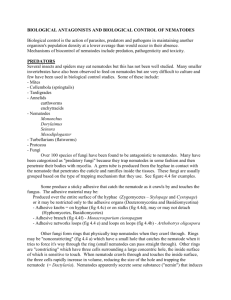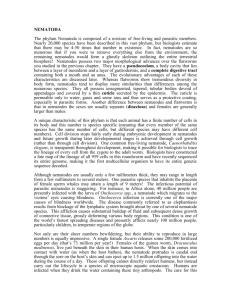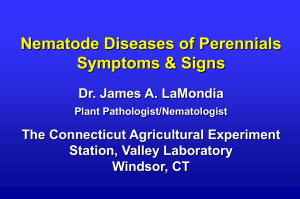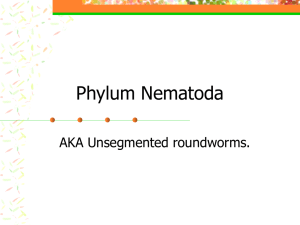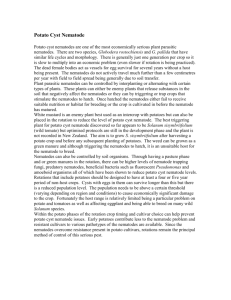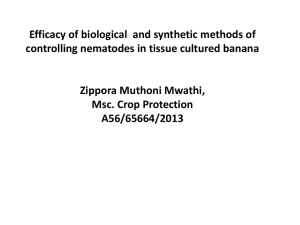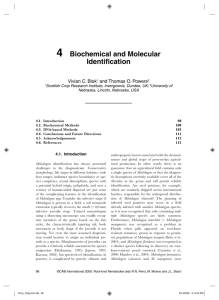`a \~ 42~5SS ~~y~LZI~~` L`IIII V`I U
advertisement
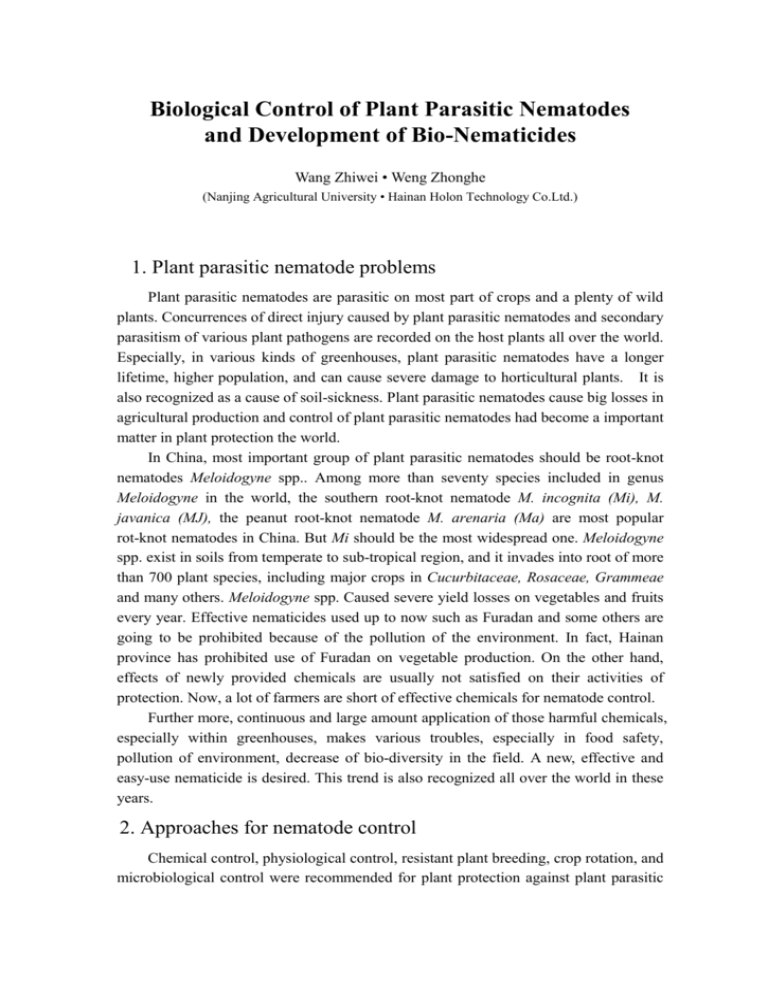
Biological Control of Plant Parasitic Nematodes and Development of Bio-Nematicides Wang Zhiwei • Weng Zhonghe (Nanjing Agricultural University • Hainan Holon Technology Co.Ltd.) 1. Plant parasitic nematode problems Plant parasitic nematodes are parasitic on most part of crops and a plenty of wild plants. Concurrences of direct injury caused by plant parasitic nematodes and secondary parasitism of various plant pathogens are recorded on the host plants all over the world. Especially, in various kinds of greenhouses, plant parasitic nematodes have a longer lifetime, higher population, and can cause severe damage to horticultural plants. It is also recognized as a cause of soil-sickness. Plant parasitic nematodes cause big losses in agricultural production and control of plant parasitic nematodes had become a important matter in plant protection the world. In China, most important group of plant parasitic nematodes should be root-knot nematodes Meloidogyne spp.. Among more than seventy species included in genus Meloidogyne in the world, the southern root-knot nematode M. incognita (Mi), M. javanica (MJ), the peanut root-knot nematode M. arenaria (Ma) are most popular rot-knot nematodes in China. But Mi should be the most widespread one. Meloidogyne spp. exist in soils from temperate to sub-tropical region, and it invades into root of more than 700 plant species, including major crops in Cucurbitaceae, Rosaceae, Grammeae and many others. Meloidogyne spp. Caused severe yield losses on vegetables and fruits every year. Effective nematicides used up to now such as Furadan and some others are going to be prohibited because of the pollution of the environment. In fact, Hainan province has prohibited use of Furadan on vegetable production. On the other hand, effects of newly provided chemicals are usually not satisfied on their activities of protection. Now, a lot of farmers are short of effective chemicals for nematode control. Further more, continuous and large amount application of those harmful chemicals, especially within greenhouses, makes various troubles, especially in food safety, pollution of environment, decrease of bio-diversity in the field. A new, effective and easy-use nematicide is desired. This trend is also recognized all over the world in these years. 2. Approaches for nematode control Chemical control, physiological control, resistant plant breeding, crop rotation, and microbiological control were recommended for plant protection against plant parasitic nematodes. In modern agricultural systems, especially in horticulture, nematode control is now mainly depending upon application chemical nematicides in the soil. Abundant application of nematicides now makes very severe troubles in agricultural production, food safety and environmental protection. So, a new, effective, environmental friendly and easy-use novel nematicide is expected. Such kind of nematicide expected to be developed through biological control research. Trials of biological control of plant parasitic nematodes are practiced all over the world. A large number of natural enemies, including parasitic and trapping fungi, mycorrhizal fungi, bacteria, viruses, nematodes, insects, mites, invertebrates, are investigated as possible biological control agents for nematode protection. The existence of nematophagous fungi had influence on nematodes was first noted by Zopf in 1888. The number of published papers on these organisms probably exceeds the number of those published on all other biological control organisms combined. Presently, over 400 species of nematophagous fungi affect on various nematodes in agricultural soils. In China, Professor Zhang Keqin in Yunnan University published an excellent specialist book on nematophagous fungi ("Studies on Nematophagoius Fungi", Yunnan University Press. 2000), and reviewed almost all nematophagous fungi in China. Nematophagous fungi are mainly divided into two classes: nematode-trapping fungi and egg-parasitic fungi. During the past years research on the use of biological agents for controlling nematodes has focused on the application of nematode-trapping fungi. Recently, egg-parasitic fungi, e.g. Paecilomyces lilacinus have become a new, attractive biological control agent for plant parasitic nematode control. By using nematode-trapping fungi, bio-nematicides Royal 300 and Royal 350 were developed for control of Meloidogyne on vegetables in France. In Philippines, on the other hand, egg-parasitic fungus Paecilomyces lilacinus was used to development of another bio-nematicide. Commercial productions of these fungi have used to be practiced in those countries. Unfortunately, inconclusive results had obtained by other investigators when those bio-nematicides were used for control of Meloidogyne. In China, development of bio-nematicides by using nematophagous fungi is actively promoted by many scientists in universities, institutes, and some companies. The interaction between nematophagous fungi and nematodes is complex, and activity of these fungi may be influenced by many factors. Bacterial agents such as Pseudomonas spp., Bacillus spp., Pasteuria penetrans and others are also studied for nematode biological control. By using Pasteuria penetrans, scientists developed a novel bio-nematicide, Pasteuria-Wettable Powder, and successfully suppressed Meloidogyne incognita at extremely low level. Pasteuria-Wettable Powder has made a great significance for nematode control in Japan. As a candidate of biorational pesticide fro plant parasitic nematode control, some Japanese scientists pay a great attention to physiological active compounds produced by Streptomyces sp.. AM (Arbuscular Mycorrhiza) and endophytic fungus are also known to affect to various plant parasitic nematodes. However, until now, Pasteuria-Wettable Powder maybe can be calculated as the most successful example of bio-nematiside. 3. Pasteuria penetrans: an obligate parasite of nematodes. From the first finding of Pateuria sp. from Pratilenchus sp. in 1940, this type of bacterial has been found from 96 genus 205 species of nematodes and P. penetrans (Pp) from root-knot nematodes, P. thornei from root lesion nematodes and P. nishizawae from cyst nematodes are identified. Pp exists in natural water or soil as a kind of endospore. The spore can adhere to the cuticle surface of secondary-stage juveniles of Meloidogyne spp.. When the spore germinated, the germ tube penetrates the cuticle layer, and develops vegetative mycelium within the juvenile. The vegetative mycelium develops into microcolony, the microcolony the daughter colonies. The daughter colony then will be fragmented in eventually quartets, doublets and Finally sporangium in which a single spore formed. Instead of nematode eggs, forth-stage juveniles infected by pp will be full with about two million Pp spores. This makes rapid decline of nematode population in the soil, mediating high protecting effect on host plants. A strict host-parasite relationship has been demonstrated between pp spores and root-knot nematodes, making this spore difficult to be cultivated on the medium but extremely safe in the environment. Even many scientists are interested with its potential as a biological control agent. However, difficulties on large-scale preparation of the spore prevent them from advanced research and development. This delayed pp application on plant protection. 4. Development of Pasturia-wettalbe powder .... Our approach ..... Using Pp, the most studied nematode parasitic bacteria, we successfully developed a bio-nematicide, and now, registration of this new bio-nematicide is going on in Japanese ministry of agriculture, Forestry and Fisheries. Here, we describe outline of the development processes: (1) Large scale preparation Based on biological characteristics of the Pp, we firstly challenged the large-scale preparation of Pp spores .we successfully overcame the difficulties on Pp propagation by mixing pp spores and nematode juveniles, inoculating to tomato seedlings, and then harvest in tomato roots when the daughter spores matured. (2) Excellent effects in both greenhouses and fields Using spores by propagated on tomato plants, we tested the protection effect of p spores from nematode injury on tomato, cucumber, pumpkin, sweet potato, container fig and many other crops in both greenhouses and fields .as shown in the table, although control effects on 1st and 2nd cropping are still not satisfied, Pp possess a long, stable and excellent protecting effect on tomato plants from 3rd cropping to 5th cropping. This indicated that pp spores could be applied as a biological control agent active against to mi when p spores are applied with chemical nematicide. (3) Formulation of the pasteuria-wettable powder Through various tests in greenhouses and fields, it was clarified that spore dispersal within the soul greatly affects on the protecting activity. According to this observation, we tested various formulations and finally selected a wettable powder formulation for best dispersal and named as pasteuria-wettable powder. (4) Toxicity and safety Pasteuria-wettable powder passed toxicological tests on microorganisms, free-living nematodes, insects, plants, fish and mammals; results of those tests indicated that Pasteuria Wettable Powder is an extremely safe bio-nematicide (5) Stability and preservation Pp spores are stable for 2 or more years at 4°C as suspension, or for 2 or more years at room temperature as a dry wettable powder, therefore, Pp spores could be preserved at 4°C in water before formulation and the pasteuria-wettable powder could be preserved at room temperature. This makes the pasteuria-wettable powder easy to handling. (6) Resistance to chemical and environmental stresses Pp sores are highly resistant to a number of nematicides used in the fields, making Pp to be possibly used together with chemical nematicides. On the other hand, once the spores were applied, they can exist, propagate and maintain their infectivity to nematodes for at least 6 hours in the field. This causes Pp spores are effective to mi for a long term in the Mi infested field. (7) Application techniques Based on the biological and plant pathological properties of Pp spores, an application draft of pasteuria-wettable powder was recommend: apply 2X10" spores /m2 with half volume of chemical nematicides in to field, followed by application of abundant water. Seven to ten days later, the field is in ready to transplanting. 5. Conclusion In the natural environment, plant pathogens live and survive in very complex situation. In conventional agriculture systems, pathogens or insects cause injury at various conditions, but the severity is usually restricted. These kinds of restriction are usually due to resistant genes in hosts, natural enemies, crop rotation, mixed cropping and so on. However, in the modern agriculture systems, these kinds of restriction usually are broken by crop improvement, abundant application of fertilizers and pesticides, extension of modern horticulture etc. Pasteuria spp. is considered to be active against to nematodes from ancient time, and their biological roles are postulated before scores of years. However, application of this bacterium for agricultural studies is not available. Our techniques on large-scale propagation and unified dispersal of Pp spores in soil led us obtained an excellent protecting activity against Mi in the field. This indicated that each or combination of conventional or basic techniques and knowledge are very important in biological control. Effect ofPasteuriapenetrans on plant vigor and fruit harvest of tomato in Japan Treament Pasteuria Chemicals Control plant 1st crop. 185 196 125 height (cm) 2nd crop. 3rd crop. 129 (141) 155 168 149 150 fruit weight Cg) 4th crop 5th crop 1405 250 225 3080 1760 1210 Pasteuria: treated with 5X109 spores/m2 of oxamy11 at 1st cropping, and additional treatment of l0g/m2 of fosthiazate at 5th croppingChemicals: Treated with 30g/m2 ofoxamyl at 1st and 4th cropping.20g/m2 ffosthiazate at 5th cropping (These results obtained from Nematech. Co. Ltd., Japan.)
